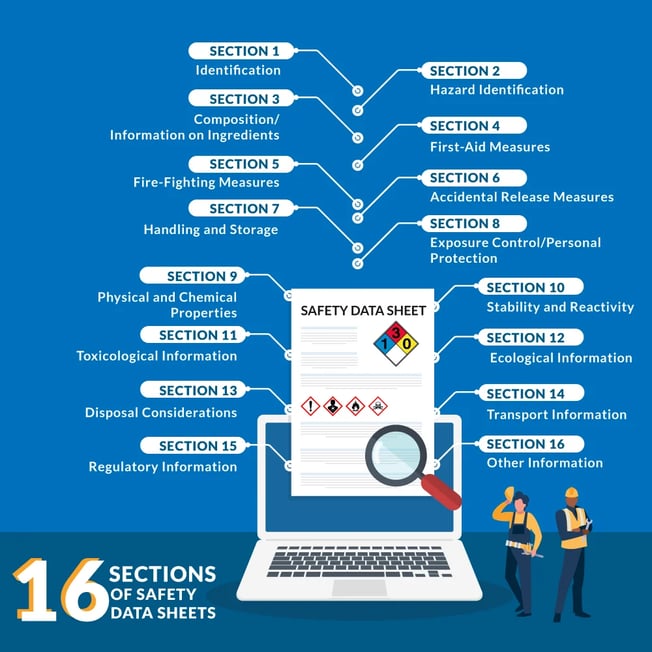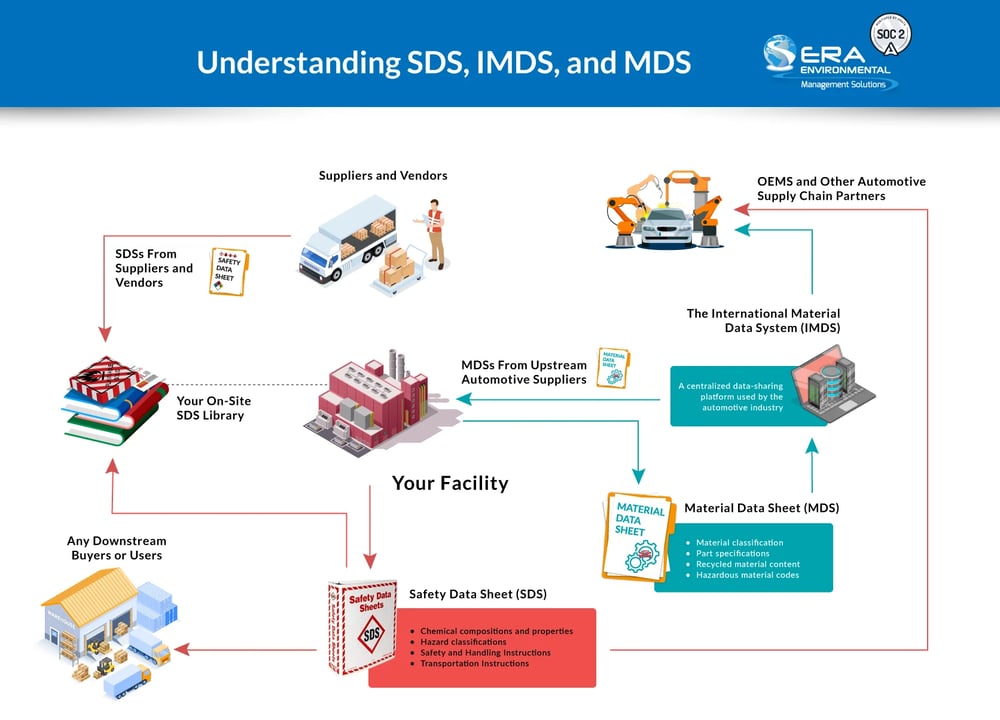SDS, MSDS, IMDS, MDS – if you’re a supplier at any level of the automotive supply chain, then you’ve likely come across these acronyms before. However, they’re distinct from one another, and understanding that is key to fulfilling your chemical management compliance obligations and meeting expected industry standards. Let’s take a closer look at these acronyms and how each of them impacts compliance and other areas for your team.
Table of Contents
What Is a Safety Data Sheet (SDS)?
Providing SDSs for Downstream Users
SDS Database Management for Workplace Safety
Safety Data Sheets and the International Material Data System
Meeting Your SDS Regulatory Compliance Obligations
What Is a Safety Data Sheet (SDS)?
A safety data sheet (SDS) is a standardized document that provides important information about chemical products. They detail the product’s physical, health, and environmental hazard classifications, along with information on protective measures, safety precautions, and transportation.
Alongside the full SDSs, there are also labels that summarize key information and must be applied directly to product containers and secondary containers. These documents play a vital role in protecting employees across the supply chain, informing them of potential hazards, and enabling better prevention and incident response.

Manufacturers are responsible for ensuring that their employees have ready access to SDSs for all chemical products onsite. They must also provide SDSs for any chemical products they manufacture for use by downstream users. Understanding these requirements is essential to maintain SDS regulatory compliance and ensure a safe workplace for everyone.
What’s the Difference Between an SDS vs. MSDS for Chemicals?
A material safety data sheet (MSDS) was once the standard document for identifying and communicating chemical hazards in the US, serving the same role as the modern safety data sheet (SDS). The US committed to adopting the Globally Harmonized System chemical safety information system for SDSs in 2012, with the transition taking place between 2013 and 2015.
MSDSs showed a lack of consistency and standardization, often being difficult to create, validate, and read. SDSs have entirely replaced MSDSs with a uniform format that organizes information into 16 intuitive categories for easier authoring and reference.
Providing SDSs for Downstream Users
The decision to provide SDSs to buyers isn’t left to the supplier’s goodwill. Instead, regulatory agencies in most countries have specific requirements for organizations to provide SDSs to relevant parties or even the general public.
In the United States, specific SDS regulations fall under the purview of OSHA’s Hazard Communication Standard (HCS). This standard lays out requirements for organizations across all industries, not just automotive. It establishes that manufacturers, distributors, and importers must provide SDSs to inform downstream users.
The standard further lays out specific requirements for the content of SDSs, following the standard Globally Harmonized System 16-section format. OSHA lays out these requirements in detail in Appendix D of 29 CFR.
Other countries have their own systems in place for standardizing SDS requirements within their jurisdictions. REACH in the European Union and WHMIS in Canada are two such examples.
Automotive suppliers that manufacture chemical products or materials or create their own blends and mixes must create SDSs for those products. These SDSs must include all required information and hazard classifications in line with the requirements of the supplier’s specific regulatory jurisdiction.
Streamlining Your Safety Data Sheet Authoring
Generating complete SDSs can take your team a considerable amount of time or require hiring an outside consultant. However, the right software solution can streamline the process considerably. ERA’s SDS Authoring Software draws on data from our Master Chemical List and other resources to automate hazard classification calculations and enable faster and more accurate SDS creation.
SDS Database Management for Workplace Safety
OSHA requires employers to maintain SDSs for any hazardous chemicals in the workplace and to make them readily accessible to employees. Traditionally, this has been handled by having large binders of physical copies of data sheets on site. Today, digital solutions make managing SDS libraries easier, saving time and improving employee access.
Manufacturers throughout the automotive supply chain make use of various paints, coatings, adhesives, sealants, and other chemicals that require SDSs. The supplier of any chemical product must provide an SDS for that product, although getting these documents from multiple vendors can sometimes become a challenging and time-consuming task.
Making SDS Document Management Easy
There’s no need to turn to bulky binders when you can implement a modern solution for safety data sheet management instead. You can manage in-house and supplier SDSs through a single system, with convenient access through any device, whether within your facility or out in the field, thanks to ERA’s SDS Management Software. You’ll also enjoy complete revision and history tracking, including built-in audit trails.
Safety Data Sheets and the International Material Data System
The International Material Data System (IMDS) is an automotive industry data-sharing system used by many of the world’s leading OEMs and automotive suppliers.
At first glance, there was sometimes some confusion when encountering the acronyms SDS and IMDS, especially when MSDSs were still in use, as both are relevant to materials found in automotive manufacturing.
Suppliers and OEMs provide important data concerning materials and components through the IMDS platform, with efficient recycling being one of the key areas of focus. This information is compiled into and stored as a Material Data Sheet (MDS), leading to further confusion. An MDS is entirely distinct from an SDS or MSDS.
An IMDS Material Data Sheet must include a variety of information, such as:
- Material classification (unalloyed steel, filled thermoplastics, lacquers, etc.)
- Public standard name and trade name
- Supplier
- Country of origin
- Recycled material content
- Inorganic, fossil-based, and bio-based material content
- Part number
- Weight
- Application codes for hazardous materials management
An SDS can serve as an important resource for creating IMDS Material Data Sheets. However, it typically does not contain all the necessary information, as the IMDS covers a variety of areas not relevant to SDSs. Likewise, an IMDS Material Data Sheet is by no means a replacement for an SDS, as it lacks data concerning hazard classification, safe handling, transportation, and other key details.

It’s important to note that while your organization faces regulatory requirements concerning SDSs, this isn’t the case for the IMDS. Providing data through the IMDS is a widespread automotive industry standard, and OEMs and other partners may require it during vendor selection. While not strictly required in the same sense as an SDS, providing data through the IMDS can help meet compliance standards, particularly in jurisdictions with recycled content regulations.
If you’re supplying any kind of chemical or chemical product to the automotive industry, your buyers will likely expect both SDSs and IMDS Material Data Sheets to accompany every product you sell.
Meeting Your SDS Regulatory Compliance Obligations
Depending on where your organization operates, you likely face standardized SDS requirements under OSHA, ECHA, or other regulatory agencies. Maintaining compliance, avoiding penalties, and keeping workers safe throughout the supply chain depends on you meeting those requirements.
ERA Environmental provides a full suite of SDS solutions. Whether you’re looking for enterprise-scale SDS Authoring Software, SDS Authoring Software on Demand, or to rely on safety data sheet authoring services from our seasoned regulatory experts, ERA can support your team with complete SDSs, labels, and certified product data sheets under a wide range of regulatory frameworks and in more than 40 languages.
To find out more about which of our SDS offerings suit your organization’s needs, please schedule a discovery call with one of our project analysts today.
Contributing Scientist of This Article:


April 22, 2024
Comments